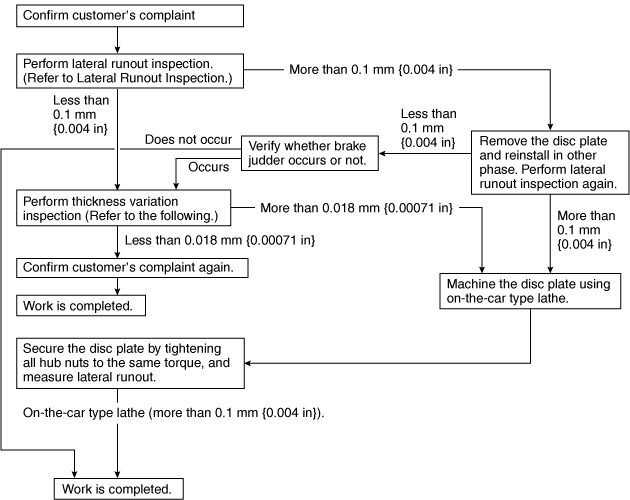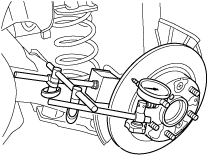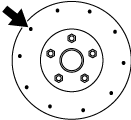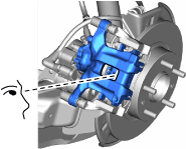REAR BRAKE INSPECTION
REAR BRAKE INSPECTION
SM2335164
id041100000800
Brake Judder Repair Hints
Description
1.Brake judder concern has the following 3 characteristics:
Steering wheel vibration
1.The steering wheel vibrates in the rotation direction. This characteristic is most noticeable when applying brakes at a vehicle speed of 100—140 km/h {62.2—86.9 mph}.
Floor vibration
1.When applying the brakes, the vehicle body shakes back and forth. The seriousness of the shaking is not influenced by vehicle speed.
Brake pedal vibration
1.When applying the brakes, a pulsating force tries to push the brake pad back. The pulsation is transmitted to the brake pedal.
2.The following are the main possible causes of brake judder:
Due to an excessive runout (side-to-side wobble) of the disc plate, the thickness of the disc plate is uneven.
1.If the runout is more than 0.1 mm {0.004 in} at the position 10 mm {0.39 in} from the disc plate edge, uneven wear occurs on the disc plate because the pad contacts the plate unevenly.
2.If the runout is less than 0.1 mm {0.004 in}, uneven wear does not occur.
The disc plate is deformed by heat.
1.Repeated panic braking may raise the temperature in some portions of the disc plate by approx. 600 °C {1,112 °F}. This results in a deformed disc plate.
Due to corrosion, the thickness and friction coefficient of the disc plate change.
1.If the vehicle is parked in damp conditions for a long time, corrosion occurs on the friction surface of the disc plate.
2.The thickness of corrosion is uneven and sometimes appears like a wave pattern, which changes the friction coefficient and causes a reaction force.
Inspection and repair procedure
am3zzw00031278
|
Lateral runout inspection
1.Remove the wheel and tire. (See WHEEL AND TIRE REMOVAL/INSTALLATION.)
2.Remove the rear brake caliper component and suspend it out of the way using a cable. (See REAR BRAKE DISC REMOVAL/INSTALLATION.)
3.Put the dial gauge on the friction surface of the disc plate 10 mm {0.39 in} from the disc plate edge.
am3zzw00025025
|
4.Rotate the disc plate one time and measure the runout.
-
Rear disc plate runout limit
-
0.1 mm {0.004 in}
Thickness variation inspection
1.Remove the wheel and tire. (See WHEEL AND TIRE REMOVAL/INSTALLATION.)
2.Clean the disc plate-to-pad friction surface using a brake cleaner.
3.Measure the points indicated in the illustration using a caliper (micrometer).
am3zzw00035058
|
4.Subtract the minimum value from the maximum, and if the result is not within the specification, machine the disc plate using a lathe.
-
Thickness variation limit
-
0.018 mm {0.00071 in}
-
Warning
-
• Do not exceed minimum disc plate thickness.
Disc Plate Thickness Inspection
-
Caution
-
• Excessive runout may result if the disc plate is removed from the vehicle then machined. Machine the disc plate while installed on the vehicle.
1.Measure the thickness of the disc plate.
-
Minimum rear disc plate thickness
-
7.0 mm {0.28 in}
-
Minimum rear disc plate thickness after machining using a brake lathe on-vehicle
-
7.8 mm {0.31 in}
-
• If the thickness is not within the specification, replace the disc plate. (See REAR BRAKE DISC REMOVAL/INSTALLATION.)
Disc Pad Thickness Inspection
1.Jack up the front of the vehicle and support it with safety stands.
2.Remove the wheel and tire. (See WHEEL AND TIRE REMOVAL/INSTALLATION.)
3.Verify the remaining thickness of the pads.
-
Minimum rear disc pad thickness
-
2 mm {0.08 in}
4.Replace the pads as a set (right and left wheels) if either one is at or less than the minimum thickness. (See REAR BRAKE DISC PAD REMOVAL/INSTALLATION.)
am3zzw00025026
|



